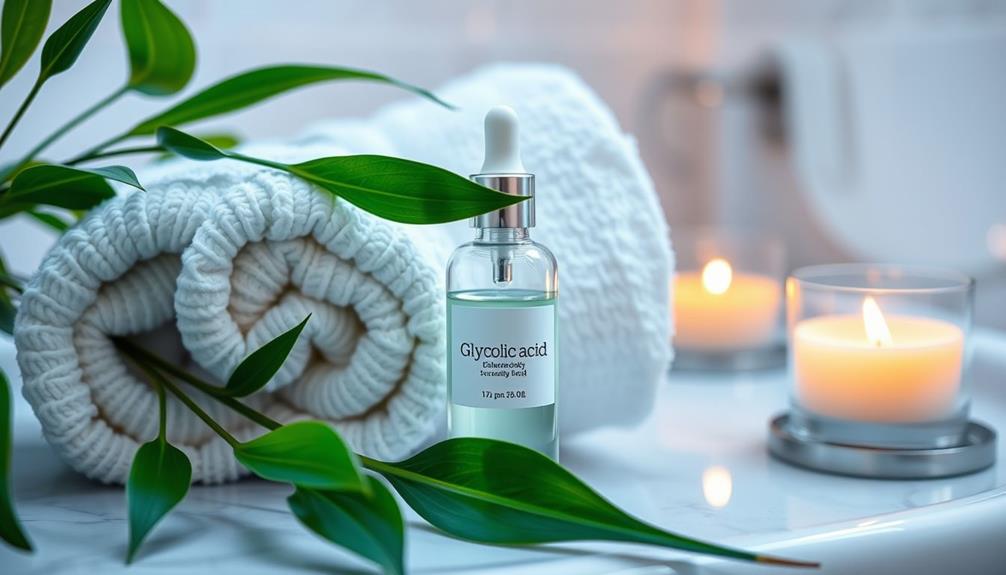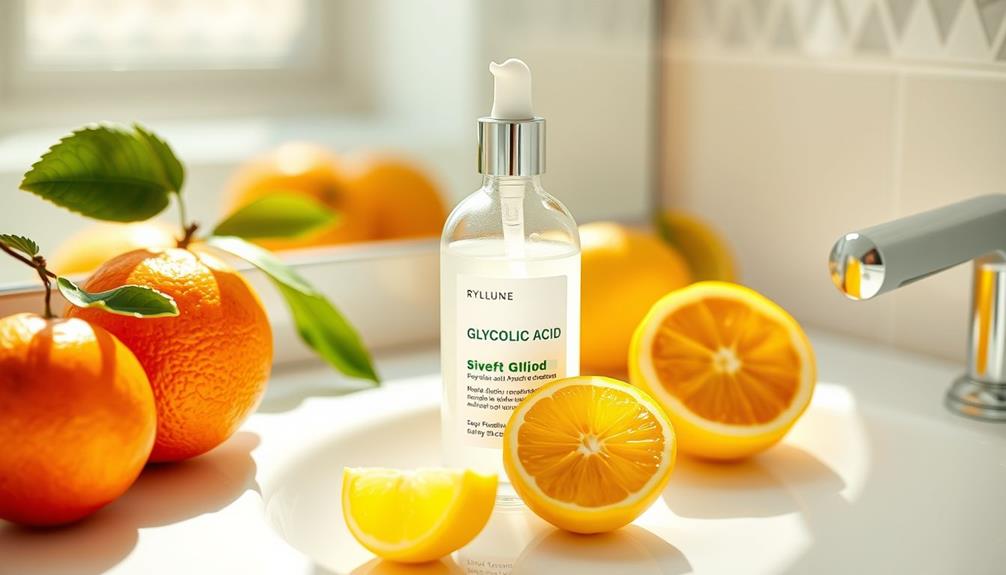Glycolic acid is a powerful ingredient that is essential for your skincare routine. As an alpha hydroxy acid, it helps to exfoliate the skin, getting rid of dead skin cells and promoting cell turnover. This can lead to improvements in fine lines, dark spots, and overall skin texture, with many users noticing a radiant complexion. In addition, it boosts collagen production to make your skin firmer and more youthful. It is important to start with lower concentrations and gradually increase usage to prevent any irritation. When used correctly, it can also help other products to absorb better. There is a wealth of benefits to be discovered about how glycolic acid can enhance your skincare routine!
Key Takeaways
- Glycolic acid is a powerful AHA that exfoliates dead skin cells, promoting cell turnover and revealing a radiant complexion.
- It stimulates collagen production, improving skin elasticity and reducing fine lines and wrinkles for a more youthful appearance.
- Regular use helps even skin tone, fading dark spots and hyperpigmentation while enhancing overall skin texture and clarity.
- User satisfaction is high, with 98% reporting smoother skin and 92% noticing reduced blemishes and improved brightness.
What Is Glycolic Acid?
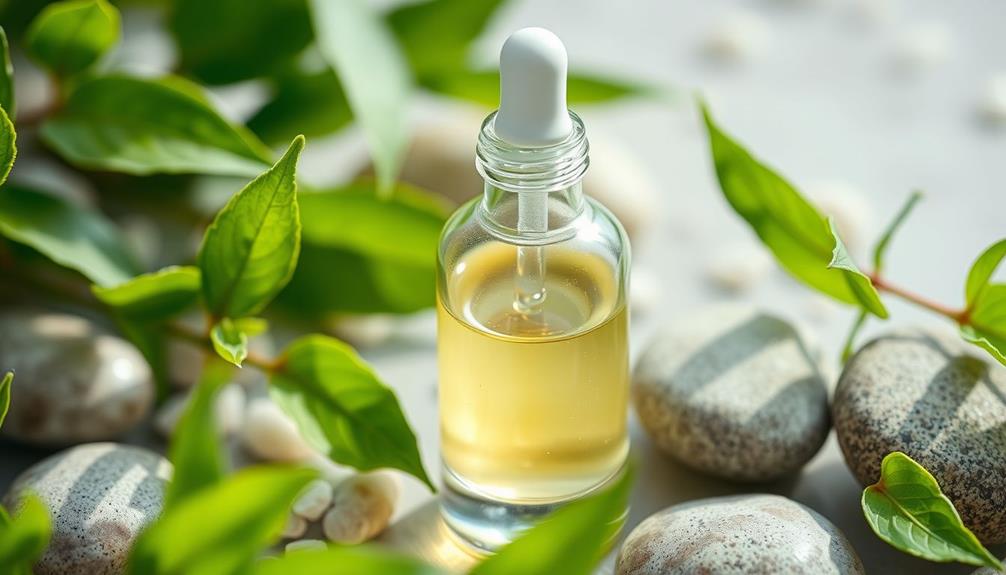
Glycolic acid is a powerful alpha hydroxy acid (AHA) that's derived from sugar cane, and it's well-known for its ability to exfoliate and rejuvenate your skin. This ingredient works by effectively removing dead skin cells, promoting cell turnover, and revealing a fresher complexion beneath.
With its small molecular size, glycolic acid penetrates deeply, stimulating collagen production to enhance your skin's elasticity and firmness. Additionally, incorporating essential oils into your skincare routine can provide complementary benefits, such as natural alternatives to chemical products that support overall skin health.
You'll find glycolic acid in various exfoliating products, making it a versatile choice for addressing multiple skin concerns. Whether you're battling fine lines and wrinkles, dark spots, or dull skin, glycolic acid can help. Its clinically proven efficacy means you can see visible results often within just a few weeks of regular use.
To maximize its benefits, look for products with a pH range between 2.8 and 3.0. This guarantees the glycolic acid remains active and effective on your skin.
Key Benefits for Your Skin

Glycolic acid offers incredible benefits for your skin, starting with its powerful exfoliation properties that reveal a radiant complexion.
It also boosts collagen production, enhancing your skin's firmness and elasticity.
Additionally, incorporating essential oils into your skincare routine can complement glycolic acid's effects, promoting overall skin health and vigor.
Exfoliation for Radiant Skin
Harnessing the power of glycolic acid can transform your skincare routine, revealing smoother and more radiant skin through natural exfoliation. This potent alpha-hydroxy acid works by dissolving dead skin cells, leading to considerable improvements in your skin's texture and clarity.
Just as somatic therapy promotes self-discovery and empowerment through movement, incorporating glycolic acid into your regimen can empower you to embrace your skin's natural beauty. By utilizing body awareness techniques alongside your skincare routine, you'll experience numerous benefits:
- Enhanced Skin Texture: Regular use promotes softer, smoother skin, with 98% of users reporting noticeable changes.
- Even Skin Tone: Glycolic acid effectively targets pigmentation issues, helping to reduce sun damage and hyperpigmentation, which evens out your skin tone.
- Clearer Complexion: It considerably reduces blemishes and blackheads, contributing to a more youthful appearance.
Exfoliation with glycolic acid not only reveals the fresh skin beneath but also encourages collagen and elastin production, improving elasticity and firmness. This means you'll not only look radiant but feel more confident in your skin.
Embrace glycolic acid in your routine and watch as your skin transforms into a smoother, clearer canvas that radiates health and liveliness.
Collagen Boosting Properties
When you incorporate glycolic acid into your skincare routine, you'll boost collagen production, enhancing your skin's elasticity and firmness for a more youthful look. This powerful ingredient stimulates the production of collagen and elastin, which are essential for maintaining your skin's structure. Regular use can lead to visible results, including reduced fine lines and improved texture.
Here's a quick overview of how glycolic acid helps your skin:
| Benefit | Explanation | Visible Results |
|---|---|---|
| Collagen Stimulation | Increases collagen and elastin levels | Firmer, plumper skin |
| Improved Texture | Promotes cell turnover | Smoother, even complexion |
| Wrinkle Reduction | Rebuilds collagen fibers | Fewer fine lines |
| Enhanced Absorption | Boosts effectiveness of other products | Better overall skin health |
| Increased Hydration | Maintains moisture levels | Hydrated, radiant skin |
How Glycolic Acid Works
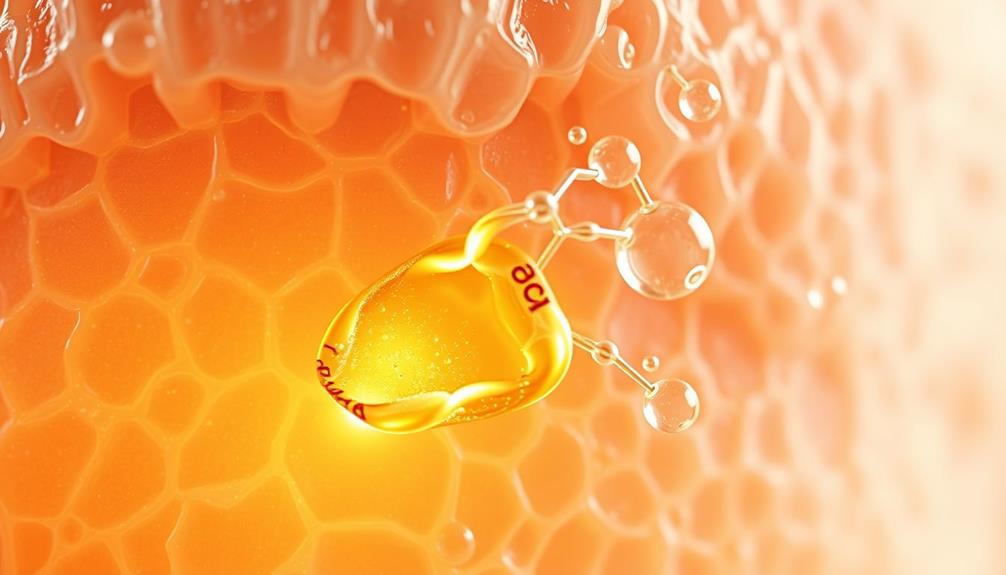
Glycolic acid works by exfoliating your skin, breaking down the bonds between dead skin cells to reveal a smoother surface.
It also promotes healthier skin by removing impurities, which is essential for maintaining a clear complexion.
Additionally, it boosts collagen production, helping your skin become firmer and more elastic.
Regular use can even out your skin tone, reducing the appearance of fine lines and hyperpigmentation.
For ideal skin health, consider incorporating regular vet check-ups into your routine to monitor overall wellness.
Exfoliation Mechanism Explained
Exfoliating your skin with glycolic acid allows it to break down the bonds between dead skin cells, promoting a smoother and more radiant complexion. This powerful alpha hydroxy acid (AHA) works effectively due to its small molecular size, which enables deeper penetration into the skin. By incorporating mindful eating and regular exercise, as suggested in menopause management, you can further enhance your skin's health from the inside out.
Here's how the exfoliation mechanism unfolds:
- Bond Breakdown: Glycolic acid disrupts the connections between dead skin cells, facilitating their removal.
- Enhanced Cell Turnover: As dead cells shed, new, healthier cells rise to the surface, resulting in smoother skin.
- pH Advantage: The low pH of glycolic acid (between 2.8-3.0) optimizes its exfoliating properties while minimizing irritation for diverse skin types.
Regular use of glycolic acid can decrease the appearance of fine lines, wrinkles, and uneven skin tone, contributing to a more vibrant complexion. By incorporating this powerful exfoliant into your skincare routine, you're not just achieving immediate results; you're also setting the stage for long-term skin health.
Embrace glycolic acid, and watch your skin transform into a smoother, more luminous version of itself.
Collagen Production Boost
Using glycolic acid can remarkably enhance collagen production, leading to firmer, younger-looking skin. This powerful alpha-hydroxy acid penetrates the skin's outer layer, exfoliating dead skin cells and stimulating cell turnover, both essential for boosting collagen synthesis.
Research shows that glycolic acid enhances fibroblast activity, which is key for increasing collagen levels and improving skin elasticity. Additionally, incorporating ingredients like natural fixes for uneven eyes can complement the effects of glycolic acid by promoting overall skin health.
When you incorporate glycolic acid into your skincare routine, you're not just treating the surface; you're encouraging deeper changes. Regular use can considerably elevate collagen levels, helping to reduce the appearance of fine lines and wrinkles.
As your skin regenerates, you'll notice a more youthful and vibrant complexion. Moreover, the low pH of glycolic acid (2.8-3.0) guarantees it penetrates effectively, stimulating collagen production without harming your skin barrier.
This means you can enjoy the benefits without worrying about irritation. By consistently using glycolic acid, you're taking an important step toward rejuvenating your skin, making it smoother and more resilient against the signs of aging.
Embrace the power of glycolic acid and watch your skin transform.
Skin Tone Evening
With its ability to break down the bonds between dead skin cells, glycolic acid promotes a more even skin tone by encouraging gentle exfoliation. This powerful alpha hydroxy acid (AHA) accelerates cell turnover, which not only helps fade dark spots and hyperpigmentation but also enhances your complexion's brightness and uniformity.
Here's how glycolic acid works its magic for skin tone evening:
- Exfoliation: By facilitating the removal of dead skin cells, glycolic acid reveals fresh, new skin underneath, leading to a smoother surface.
- Cell Turnover: The acid speeds up the natural shedding process, which helps diminish discoloration and encourages a more radiant appearance.
- Reduces Inflammation: Regular use can calm redness and irritation, especially beneficial for sensitive or acne-prone skin, resulting in a more balanced skin tone.
Research shows that consistent application of glycolic acid improves skin texture and tone, promoting luminosity and elasticity.
With a low pH, its formulations penetrate effectively, ensuring you achieve that sought-after even skin tone.
Make glycolic acid a part of your routine and watch your skin transform!
Usage Guidelines and Best Practices
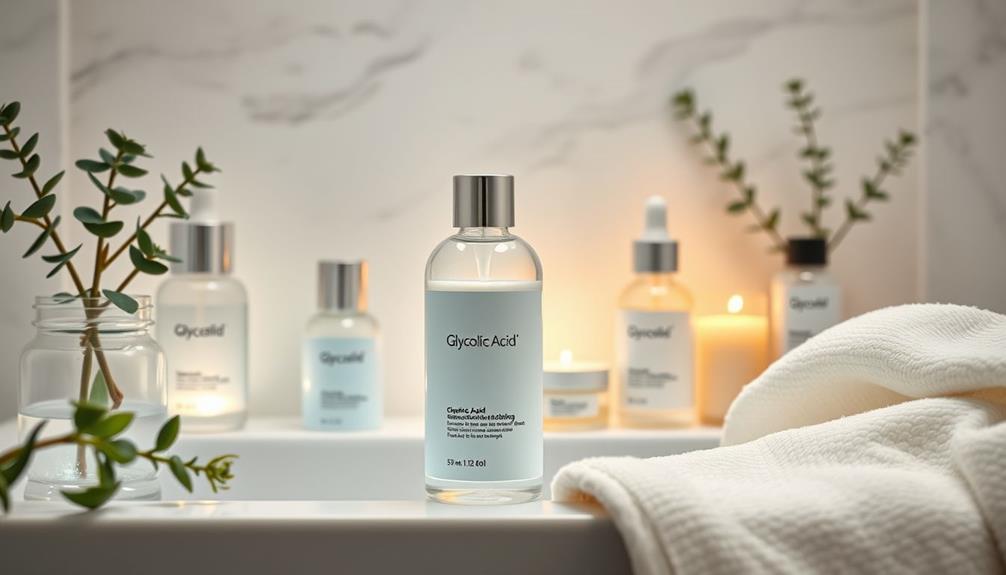
To achieve the best results from glycolic acid, apply it 2-3 times a week on clean, dry skin, gradually increasing usage as your skin adapts.
Start with a lower concentration of glycolic acid serum to minimize irritation, especially if you have sensitive skin.
Consider layering it with hydrating products like face oils or moisturizers to enhance comfort.
For ideal results, use glycolic acid treatments in the evening. This allows the active ingredients to work overnight while your skin repairs itself.
Don't forget to apply sunscreen during the day, as glycolic acid can make your skin more sensitive to UV rays.
When integrating glycolic acid into your routine, be cautious about combining it with other strong active ingredients like retinol or vitamin C. This helps maintain skin balance and prevents irritation during initial use.
Consistency is key; many users report noticeable improvements in skin texture, clarity, and tone within weeks of regular use.
Clinical Evidence and Results

How effectively does glycolic acid enhance skin texture and appearance? The clinical evidence is compelling. Studies show that glycolic acid is a powerful player in skin care, markedly improving elasticity, tone, and luminosity.
You'll find that users often report remarkable texture improvements after consistent use. Here are some key findings:
- 98% of users experienced softer and smoother skin, underscoring glycolic acid's effectiveness as an exfoliant.
- 92% of participants noted reduced hyperpigmentation and blemishes, revealing its skin-brightening properties.
- Glycolic acid not only accelerates cell turnover but also stimulates collagen synthesis, helping to reduce fine lines and wrinkles.
Moreover, those who combined glycolic acid with soothing ingredients like organic aloe vera acclimated faster, with 92% reporting smoother changes to nightly use.
This clinically proven ingredient is a must-have for anyone looking to elevate their skin care routine. If you're considering incorporating glycolic acid into your regimen, the results speak for themselves—clearer, smoother, and more radiant skin is within your reach.
Common Skin Concerns Addressed

Glycolic acid effectively tackles common skin concerns like fine lines, hyperpigmentation, and acne by promoting cell turnover and enhancing overall skin texture.
When you incorporate glycolic acid into your skincare routine, you stimulate collagen production, which helps reduce the appearance of fine lines and wrinkles. This ingredient also works wonders for uneven texture, as it encourages the shedding of dead skin cells, revealing fresher, smoother skin underneath.
If you're dealing with dark spots or pigmentation issues, glycolic acid can be a game changer. By accelerating cell turnover, it helps fade those pesky marks and can even out skin tone over time.
Additionally, its natural exfoliating properties cleanse your skin follicles, which can greatly reduce the occurrence of acne, blackheads, and breakouts.
Regular use of glycolic acid not only helps with these concerns but also enhances your skin's overall texture, leading to a softer, healthier glow.
If you want to address sun damage or dull skin, glycolic acid is a key ingredient to take into account.
Embrace the potential of glycolic acid and experience transformative results for your skin.
Incorporating Into Your Routine
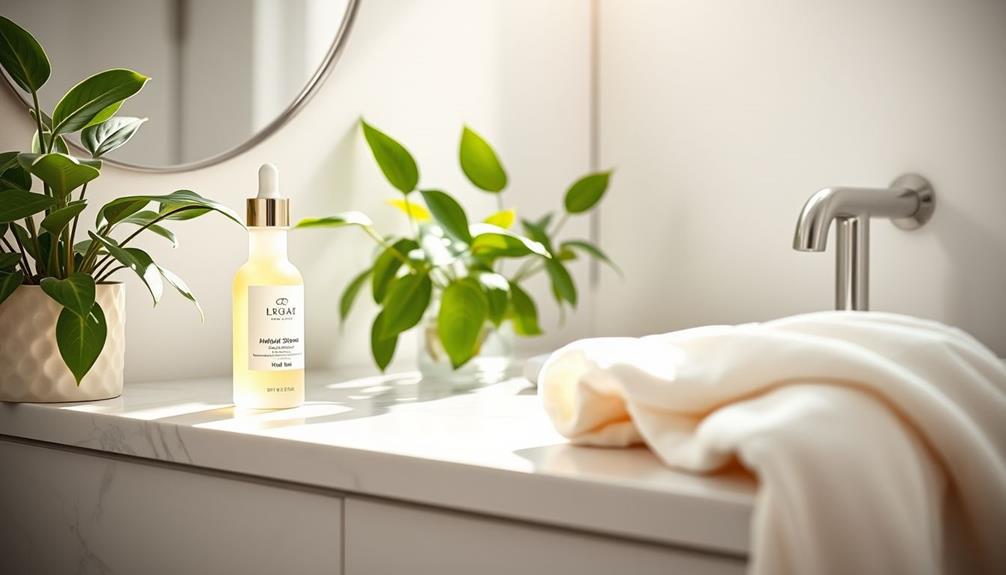
Regularly incorporating glycolic acid into your skincare routine can lead to noticeable improvements in your skin's texture and clarity. To get started effectively, follow these steps tailored to your skin type:
- Start Slowly: Use glycolic acid products like Liquid Gold three times a week on alternate evenings. This gradual approach helps your skin acclimate to its exfoliating effects.
- Apply Properly: After cleansing, apply your glycolic acid serum or treatment using a cotton pad or your palms for even coverage. Avoid layering it with other active ingredients to maintain its efficacy.
- Hydrate: Once the glycolic acid has dried, incorporate additional hydrating products like face oils. This step is essential for replenishing moisture and enhancing skin hydration, especially for those with dry or sensitive skin types.
Sustainability and Ethical Practices

Sustainable and ethical practices are becoming essential in the skincare industry, with many brands prioritizing eco-friendly packaging and responsible ingredient sourcing.
You'll find that many glycolic acid products now come in containers made from 100% post-consumer recycled plastic, reducing waste and environmental impact. Additionally, some brands commit a portion of their sales—like 1%—to support initiatives such as Women in Ocean Science, showcasing their dedication to sustainability.
When choosing glycolic acid products, look for those that emphasize vegan and cruelty-free formulations. These brands guarantee their products contain no animal-derived ingredients or harmful additives, aligning with your values of compassion and eco-friendliness.
The sourcing of ingredients is also vital; many companies focus on organic aloe vera and natural compounds that not only promote healthy skin but also support a cleaner, greener planet.
Real User Experiences and Testimonials

Many users have raved about their transformative experiences with glycolic acid, highlighting significant improvements in skin texture and clarity. With a remarkable 98% satisfaction rate in clinical trials, it's clear that many have found success with this powerful ingredient.
Here are some common benefits users have reported:
- Reduced Fine Lines: About 87% of users noted a decrease in fine lines and wrinkles, showcasing glycolic acid's strong anti-aging properties.
- Improved Skin Clarity: Users aged 25-54 observed clearer and brighter skin almost immediately, with 92% seeing a reduction in hyperpigmentation and blemishes within weeks.
- Enhanced Texture for Sensitive Skin: Even those with sensitive skin experienced an overall improvement, as 97% reported softer, smoother skin after incorporating glycolic acid into their routine.
These testimonials reinforce glycolic acid's reputation as a skincare miracle, proving that it can help address various skin concerns.
If you're looking for a reliable solution to enhance your skin's appearance, it might just be the answer you need.
Frequently Asked Questions
Do Dermatologists Recommend Glycolic Acid?
Yes, dermatologists recommend glycolic acid for its effective exfoliation properties. It improves skin texture, reduces fine lines, and enhances luminosity. Just start gradually, especially if you have sensitive skin, to avoid irritation.
Who Should Avoid Glycolic Acid?
Research shows about 15% of individuals with sensitive skin may react negatively to glycolic acid. If you have eczema, rosacea, open wounds, or are pregnant, you should definitely avoid using glycolic acid to prevent irritation.
Do You Really Need Glycolic Acid?
If you want to enhance your skin's texture and tone, you might find glycolic acid beneficial. It promotes cell turnover, reduces fine lines, and helps with uneven pigmentation, giving you a fresher, more radiant complexion.
Can I Use 7% Glycolic Acid Every Day?
You might think using 7% glycolic acid daily is fine, but it can irritate many skin types. Start with 2-3 times a week, then increase as your skin adjusts. Always wear SPF to protect your skin!
Conclusion
Glycolic acid isn't just for the skincare enthusiasts; it's for anyone ready to elevate their routine.
You might worry about irritation, but with the right concentration and gradual introduction, you can enjoy its benefits without the fear.
By incorporating glycolic acid, you're not just treating your skin; you're investing in a brighter, smoother complexion.
So why not give it a try? Your skin will thank you, and you'll love the confidence that comes with it!

